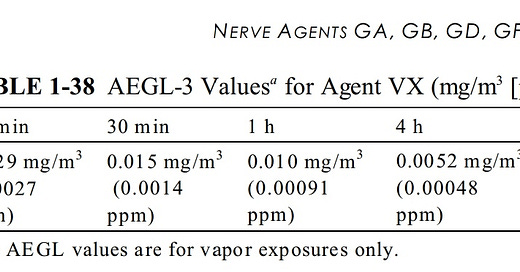An insight into neurotoxic and toxicity of spike fragments SARS-CoV-2 by exposure environment: A threat to aquatic health?
(January 2021)
Any extracts used in the following article are for non commercial research and educational purposes only and may be subject to copyright from their respective owners.
Context
This study used spike protein in aquatic concentrations of 100 & 500 nanograms per millilitre
= 0.1 & 0.5 parts per million.
Not quite in the same league as VX, one of the most lethal nerve poisons ever made but still toxic at much lower levels than hydrogen cyanide, it's nasty stuff!
Reactive oxygen species (ROS) generation is significant too, which I've explored previously.
“The AEGL-1 is based on human monitoring studies in which the preponderance of data as a weight-of-evidence consideration indicates that an 8-h exposure to HCN at 1 parts per million (ppm) would be without adverse health effects for the general population. “
https://www.ncbi.nlm.nih.gov/books/NBK207601/
The Cholinergic System:
Definition
The cholinergic system is composed of organized nerve cells that use the neurotransmitter acetylcholine in the transduction of action potentials. These nerve cells are activated by or contain and release acetylcholine during the propagation of a nerve impulse. The cholinergic system has been associated with a number of cognitive functions, including memory, selective attention, and emotional processing.
Full paper:
https://link.springer.com/referenceworkentry/10.1007/978-0-387-79948-3_1113
The paper:
An insight into neurotoxic and toxicity of spike fragments SARS-CoV-2 by exposure environment: A threat to aquatic health?
Abstract
The Spike protein (S protein) is a critical component in the infection of the new coronavirus (SARS-CoV-2). The objective of this work was to evaluate whether peptides from S protein could cause negative impact in the aquatic animals. The aquatic toxicity of SARS-CoV-2 spike protein peptides derivatives has been evaluated in tadpoles (n = 50 tadpoles / 5 replicates of 10 animals) from species Physalaemus cuvieri (Leptodactylidae). After synthesis, purification, and characterization of peptides (PSDP2001, PSDP2002, PSDP2003) an aquatic contamination has been simulatedwith these peptides during 24 hours of exposure in two concentrations (100 and 500 ng/mL). The control group (C) was composed of tadpoles kept in polyethylene containers containing de-chlorinated water. Oxidative stress, antioxidant biomarkers and neurotoxicity activity were assessed. In both concentrations, PSPD2002 and PSPD2003 increased catalase and superoxide dismutase antioxidants enzymes activities, as well as oxidative stress (nitrite levels, hydrogen peroxide and reactive oxygen species). All three peptides also increased acetylcholinesterase activity in the highest concentration. These peptides showed molecular interactions in silico with acetylcholinesterase and antioxidant enzymes. Aquatic particle contamination of SARS-CoV-2 has neurotoxics effects in P. cuvieri tadpoles. These findings indicate that the COVID-19 can constitute environmental impact or biological damage potential.
Link to full paper pdf:
Pathology:
Cholinergic Toxicity
Cholinergic toxicity is caused by substances that stimulate, enhance or mimic the neurotransmitter acetylcholine, the primary neurotransmitter of the parasympathetic nervous systems. Acetylcholine stimulates muscarinic and nicotinic receptors to cause muscle contraction and glandular secretions. Cholinergic toxicity occurs when too much acetylcholine is present in the receptor synapse leading to excessive parasympathetic effects.
Pathophysiology
The underlying mechanism for cholinergic toxicity is excessive cholinergic receptor stimulation which can be caused by substances that mimic, stimulate, or enhance acetylcholine. The symptom complex produced by the agent depends on what type of receptor or combination of receptors is activated. There are three types of cholinergic receptors: central, muscarinic, and nicotinic. Excess acetylcholine at muscarinic receptors will result in symptoms of increased secretions, bronchoconstriction, bradycardia, vomiting, and abdominal cramping. Excess acetylcholine at nicotinic receptors causes muscle fasciculations or paralysis due to activation of the neuromuscular junction. Acetylcholine excess in the central nervous system can cause confusion, headache, or drowsiness.[1]
More:
https://www.ncbi.nlm.nih.gov/books/NBK539783/
Can we translate these findings to humans? Indeed it would appear so. But the neurotoxicity is not of course due to VX or hydrogen cyanide, but something equally dramatic: snake venom.
To be more specific: bungarotoxin, “…“toxin-like” epitope on the Spike glycoprotein, with homology to a sequence of a snake venom toxin.“
As an aside, there are other potentially neurotoxic sequences too like GP120, as discussed on a previous Substack. Bungarotoxin tends to cause paralysis & cramps through dysregulating neurotransmitters, whereas GP120 is neurotoxic through causing apoptosis.
More:
https://en.m.wikipedia.org/wiki/Bungarotoxin
Nicotinic cholinergic system and COVID-19: In silico identification of interactions between α7 nicotinic acetylcholine receptor and the cryptic epitopes of SARS-Co-V and SARS-CoV-2 Spike glycoproteins (2021)
Abstract
SARS-CoV-2 is the coronavirus that originated in Wuhan in December 2019 and has spread globally. Studies have shown that smokers are less likely to be diagnosed with or be hospitalized for COVID-19 but, once hospitalized, have higher odds for an adverse outcome. We have previously presented the potential interaction between SARS-CoV-2 Spike glycoprotein and nicotinic acetylcholine receptors (nAChRs), due to a “toxin-like” epitope on the Spike glycoprotein, with homology to a sequence of a snake venom toxin. This epitope coincides with the well-described cryptic epitope for the human anti-SARS-CoV antibody CR3022. In this study, we present the molecular complexes of both SARS-CoV and SARS-CoV-2 Spike glycoproteins, at their open or closed conformations, with the model of the human α7 nAChR. We found that all studied protein complexes' interface involves a large part of the “toxin-like” sequences of SARS-CoV and SARS-CoV-2 Spike glycoproteins and toxin binding site of human α7 nAChR. Our findings provide further support to the hypothesis about the protective role of nicotine and other cholinergic agonists. The potential therapeutic role of CR3022 and other similar monoclonal antibodies with increased affinity for SARS-CoV-2 Spike glycoprotein against the clinical effects originating from the dysregulated cholinergic pathway should be further explored.
Keywords: COVID-19, Cryptic epitope, CR3022, Molecular modeling, nAChRs, SARS-CoV-2, Spike glycoprotein
Full paper:









Re: nicotine
https://archive.4plebs.org/pol/thread/332125809/